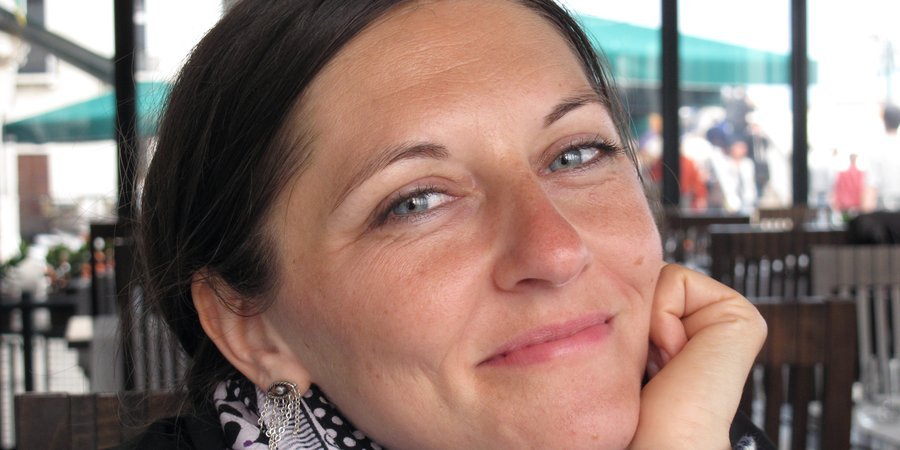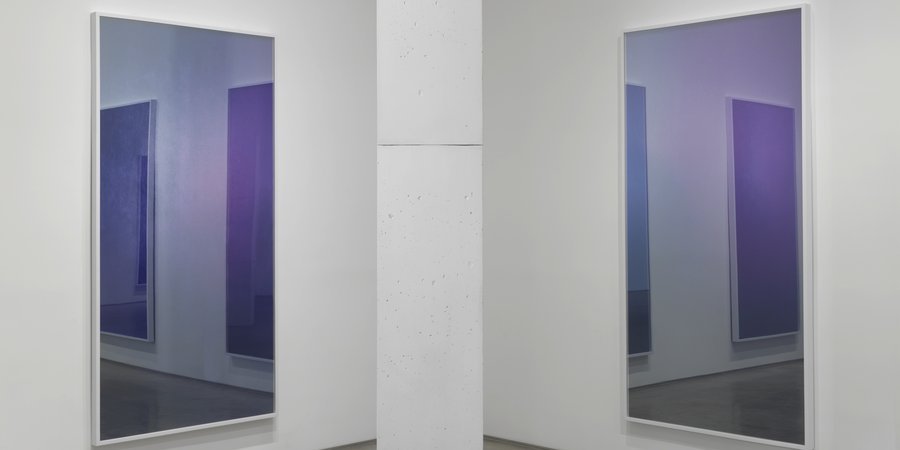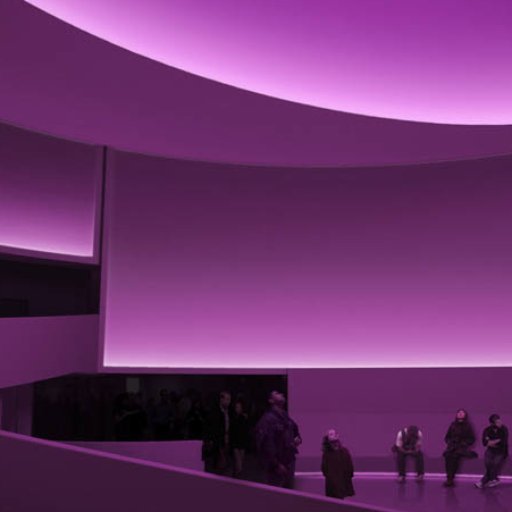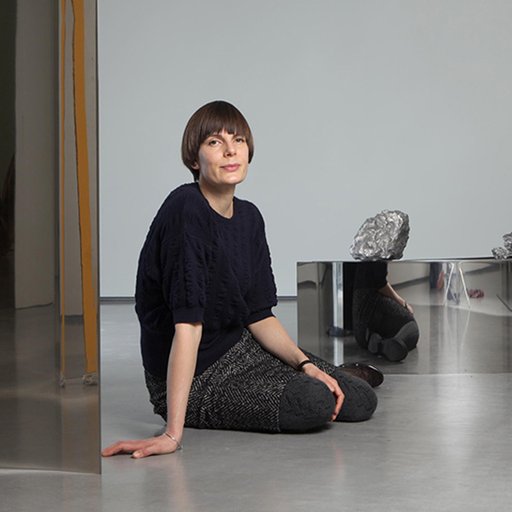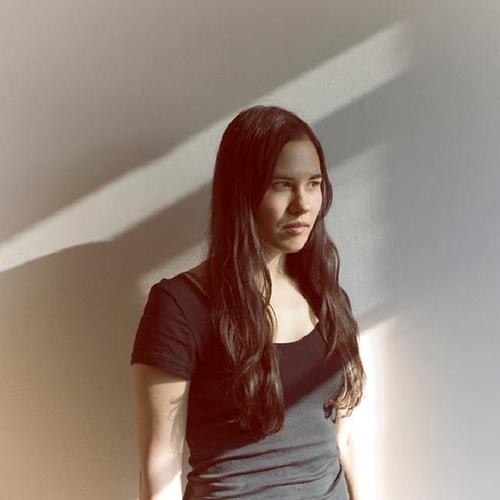For years, the New York-based artist Sara VanDerBeek would build an intricate piece of sculpture, painstakingly updating classic constructions of Modern art familiar from the work of Man Ray, Picasso, and other touchstones; then she would photograph the sculptures in dramatically lit stage settings; then she would destroy the sculpture and exhibit the photographic image, elegantly displayed in a sleek minimal frame. This process, suffused with a kind of nostalgia for a half-real past, understandably garnered attention, landing VanDerBeek a solo show at the Whitney in 2010.
Now, in her latest body of work, the artist is exploring a dramatically new direction. Instead of confining herself in her studio, VanDerBeek ventured out to visit Greco-Roman archeological sites across Europe, creating vividly hued photographic works inspired by the ancient representations of women that she discovered on her journey. She also made an associated group of sculptures relating to the same theme. This time, however, she kept the sculptures. Collectors, you can breathe easy.
Here, Artspace editor-in-chief Andrew M. Goldstein spoke to the artist—the daughter of celebrated experimental filmmaker Stan VanDerBeek, and a protégé of the late conceptual photographer Sarah Charlesworth—about the evolution in her work.
Your current show at Metro Pictures seemed to mark a new stage in your work. For one thing, while you have long drawn on art history for your photographs—alluding to Surrealism and early Modernism, for instance—there you looked back further in time, to antiquity. What was it that drew you to work with classical sculpture?
I have always had an interest in classical sculpture, and in particular the photographic reproductions of it that are found in art history anthologies. They are iconographic, and symbolic of our ideas of the past and our ideals—but more importantly they are, in their current state, a meeting of times. When traveling to these sites, something that continually struck me was how through these objects the past was imminently present, and in general it made me think about our relationship to history, our understanding of it, our romantic and critical views of it, and how we are still striving to understand it further.
Although they are often frontal and very controlled in their composition, classical sculptures are also very dynamic. They shift states of being. When viewing them, they appear almost more like images than three-dimensional forms because they are so recognizable, but then you turn and the perspective completely changes and you're reminded that they have mass and are in fact sculptures. I connected their multiplicity—the repeated poses and shapes of the bodies, which means that the same figures often appear in different museum collections—to the reproductive nature of photography, and was interested in exploring this doubling or mirroring of these figures as an overall idea for the show.
The tastefully minimal white marble Greek and Roman sculptures that today are viewed as the paragons of classical art are in fact very different to what the ancients saw, because their sculptures were not white but painted in bright, brilliant colors that have since worn off. You play with this idea in your new photographs, which overlay images of classical sculptures with blue and pink plexiglas, returning color to the works. Why did you decide to focus on those two hues in particular?
I felt like when I saw remnants of pigment on these sculptures, pink and blue were the colors that remained. The pink was probably more of a red originally. Reading a text on the history of Rome, I learned that emperors would often appear with their faces painted red during ceremonial presentations as a sign of their strength and vitality. Blue is used symbolically throughout art history, and the fragmentary presence of that color on these sculptures and its use in later Renaissance,Baroque and Modern paintings was something that I came to feel was the accumulative tone of my experience.
The layered Plexiglas over the pieces, meanwhile, makes the image appear more slowly. It's almost like an after-image—my hope was a dreamlike image that is recognizable but difficult to grasp. I think these pieces are also an attempt to explore, through their composition and the layered coloring, the body as a space of reflection, not just idealization. Yet these are definitely idealized forms, and I embraced that. The figures depicted in a number of these images are actually neo-classical sculptures. I was interested in that movement because neo-classicism came at a challenging time, and the mix of modernist ideals and classical aspects that appear in these sculptures was interesting to me as a foreshadowing of more contemporary practices, including certain qualities of pop-culture imagery that continue to be a part of our contemporary visual language.
You also exclusively treat sculptures of women in your new works. Why is that?
Coming off of a series I photographed of dancers for a recent show in London, I was thinking about the body and women’s bodies as this changing space of interpretation, and how over time their depiction as it changes conveys the culture of their creation—more so, I think, then the male figure. But what is also interesting to me about Classical art—Greco-Roman art at least—is that the figures are androgynously beautiful. They are in some ways universal, in that they're both male and female. I'm sure some of this interest comes from the fact that I am a woman.
To prepare this show you traveled to archeological sites and museums in Rome, Naples, and Paris. Where did you find the most fertile material? And what did you learn about art from your Grand Tour?
It's still very inspiring, and provided me a unique education. I learned a lot from my time in Europe visiting these sites and from creating this series. I got the most out of my experience in the National Archeological Museum in Naples and in several smaller collections in Rome that were housed in former Palazzos. It's a very different experience from seeing the work in a standard museum. In Naples, I was most impressed by the scale of the sculptures in the Farnese collection. I had never seen classical figures at that scale before.I was inspired to create the four cast-concrete forms that were in the second gallery by the monumental female figures that once adorned the Baths of Caracalla, and which are now part of the Farnese collection. But the most significant thing I took away from my trip was feeling very present as I moved around these sculptures and objects of the past.
How do you feel contemporary art relates to classical sculpture?
The fact that the sculptures were originally painted felt to me like a meeting of image and object—somehow, in the simultaneity that is engendered by this act, it caused a shifting in my understanding of these objects. It's open but it is also a very succinct. With this, I felt that these ancient objects spoke to the ongoing and ever-evolving relationship between photography and sculpture, and form and idea, that is a strong part of many contemporary practices.
Another notable shift that can be seen in your new body of work is that you are now showing sculpture alongside your photography. For years your process involved creating sculptures in your studio, photographing them, and then destroying the sculptures. What inspired that approach? And what led you to start showing the sculptures themselves?
I am interested in the way the camera frames and captures a fixed yet shifting perspective. I say this because of the subjectivity that is mixed with the concrete reality of the photographic process. I still work with negatives and film cameras, but I print digitally. I like how photography is constantly expanding and elastic, and I enjoy how images of objects, sites, situations, and people are recognizable as something actual—it existed in the world as recorded by the camera, but is also very much mediated by the person operating the camera. A photograph is a fixed viewpoint and a discrete image, but our understanding of it—especially if it is a recognizable or iconographic image—is always changing.
With earlier works I was attempting to create a quality of simultaneity, of multiple times and spaces within the same image. As my work has continued, I've become interested in exploring the sense of the singular moment and attempting to capture and convey the ephemeral or fleeting nature of photographic images. This caused me to separate further the two aspects of my practice—photographing out in the world and my studio-based work. My work relating to three recent exhibitions led to me presenting sculptures alongside photographs rather then photographing them.
Your brother, Johannes VanDerBeek, is a celebrated sculptor in his own right, and you have worked with him on projects before. How has that collaboration informed your work?
It was after working with Johannes on a yearlong project with Ian Berry at Skidmore's Tang Museum—along with my process for my exhibition To Think of Timeat the Whitney Museum, and a residency at the Hammer Museum—that I decided to exhibit objects along with the images. Having an intimate view of my brother’s approach to sculpture was very inspiring. He has an incredibly dynamic approach to materials and form that made me acutely aware of the unique experience of space and scale that occurs when viewing sculpture in person.
For some of the images in my show at the Whitney Museum, I photographed cast objects that are similar in form to some of the sculptures I am showing now. It was also during this project—and when I was creating an earlier work called A Composition for Detroit—that the physical site and on-location photographic research became such an important part of my process. At the Hammer, I created a set-like tableaux in which sculptures were housed along with photographs, creating a space that was somewhere in between an actual and an imagined situation. My installation of images and objects at Metro Pictures followed along these lines and was inspired by the museum tableaux of the collections I visited.
Do you ever regret dismantling the sculptures?
I didn’t, because they were built with their impermanence in mind. At the time I enjoyed their lack of structural integrity and their temporariness. I never felt they were props, though, and thought of them more as sculptures or assemblages. I enjoyed the freedom that creating them for the capture of the camera encouraged. That being said, when it came time to take the pictures, that was the most difficult point in the process for me because it meant that there needed to be a moment of finalization. I enjoy now that, up until the show opens, I can continue to re-arrange and change the installations. Now the show becomes more like the way I was working in the past in the studio. It feels less fixed that way, and I enjoy the flexibility of that experience.











